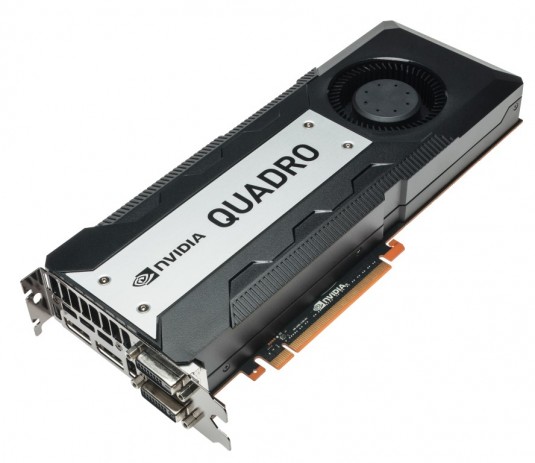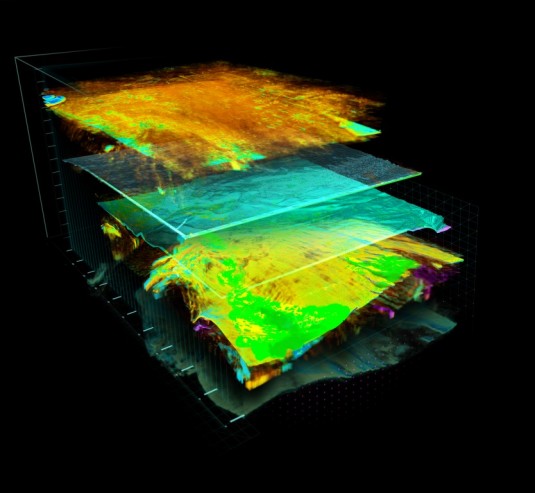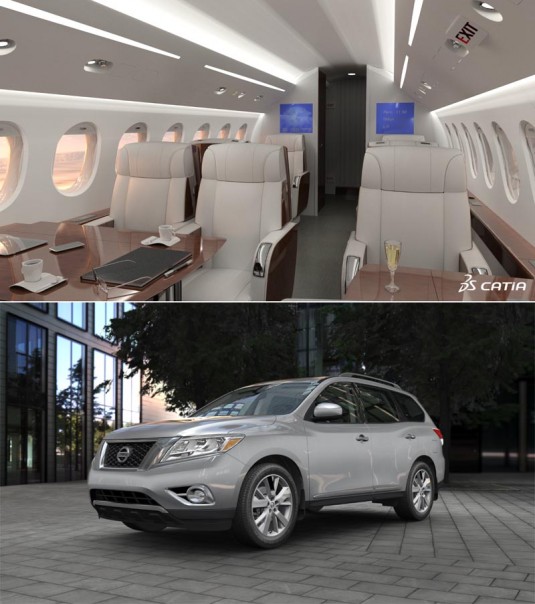A whopping 12 gigabytes of on-board memory takes the K6000 where no single-board GPU has gone before.
By Alex Herrera
It certainly didn’t take a whole lot of speculation to see what was coming from Nvidia’s professional graphics business next. But that didn’t make the company’s Siggraph unveiling of its new top-end Quadro K6000 GPU any less impressive. It raises the bar in terms of virtually every metric one might use to measure professional graphics cards … (most likely) including price.
The far-and-away volume leader in professional graphics, in recent years Nvidia’s carved out some consistent numbering in its SKUs serving the various segments of the market. The previous generation of products built around the company’s Fermi GPU included the Quadro 400, 600, 2000, 4000, 5000 and 6000, from lower price to higher.
That made the transition to products built around the more recent Kepler GPU quite predictable, as the company used the same numbering for each tier, adding a “K-” prefix to denote Kepler. First there was the ultra-high end Quadro K5000, which was followed by the high end Quadro K4000, mid-range Quadro K2000, and entry-class Quadro K600 and Quadro 410 (without the “K-”, we presume for marketing reasons). The one number missing was the 6000, but no longer, as Nvidia at Siggraph introduced the Quadro K6000, the Kepler-class successor to the old Fermi-based 6000.

Equipped with about two times the computational resources of the K5000 and three times the memory, the K6000 sets itself apart from any other workstation-caliber graphics card on the market. All told, compared to its Fermi-class predecessor, the K6000 promises twice the memory, 1.7 times the graphics performance, and five times the graphics performance. Nvidia says the card will be available sometime this fall.
Largest video memory footprint ever
The first Kepler chip Nvidia produced, the GK104, remains the flagship of the generation. Up to now, it’s driven all of the highest performing consumer (GeForce) and professional (Quadro) cards, with the exception of the uber-gamer GTX Titan card. However, the GK104 had a cousin, the GK110, an amped-up version shaped primarily to serve the company’s Tesla-brand, GPU-compute products. And it’s the GK110 that’s now showing up under the Quadro brand in the new K6000.
A conscious strategy of Nvidia, the GK110 exploits all of the general goodness of the base Kepler architecture, but adds several non-trivial features like Dynamic Parallelism, Hyper-Q, GPUDirect, and an enhanced Grid Management Unit. It also includes a whole lot more of the atomic processing units called CUDA cores, a total of 2880 compared to the GK104’s 1536, as well as dedicated (i.e. much faster) double-precision floating-point hardware.
The selection of the GK110 was no surprise, as it’s the only Kepler derivative chip that can best the GK104. And since the latter is powering the K6000’s little brother, the K5000, there was really only one chip worthy to power the new card.
However, while the choice of the GK110 was no surprise, the impressive amount of memory was. Consider that the K6000’s predecessor offered 6 GB and that its lesser sibling, the K5000, supports 4 GB, we might have guessed 8 GB for the new top-end card. But Nvidia threw in even more, doubling the old Quadro 6000’s memory to a not-before-seen 12 GB of GDDR5 video memory. Huge.
Of course, the larger memory footprint comes with added complexity and silicon area, at a cost. Factor in the companion 12 GB of memory, and the Quadro K6000 will sport a hefty price tag. How hefty? Well, Nvidia hasn’t said yet, but we’d estimate its MSRP at least matches the $5K price of its predecessor.
Who needs it? And who can afford it?
Who are the customers who can benefit from 12 GB of memory and almost double the raw TFLOPS of the pretty-darn-capable Quadro K5000? Well, lots could. The better question is, who wants that kind of performance bad enough to cough up $5K or more? Not that many, though probably a lot more than you might think. Companies involved in oil and gas exploration, for example, have never represented a large volume of workstation and professional graphics units. Rather, the bulk has always gone to more mainstream CAD and Digital Media Entertainment (DME) segments of the market. But what these buyers lack in volume, they make up for in ASPs, as they are typically not the customers to skimp on capability to save a few dollars … or even a few thousand dollars.

The costs of drilling new oil or gas fields are enormous, in both dollars and time, so knowing where to look is Job One. Surveys are both expansive and detailed, resulting in single data sets that can push well beyond 1 TB, the sheer magnitude of which invariably leads to system bottlenecks, due to lack of sufficient storage and bandwidth. The K6000’s massive 12 GB frame buffer, accessed at 288 GB/sec, offers more storage and bandwidth than any other single-card solution has ever been capable before.
As Klaas Koster, responsible for seismic interpretation at Nvidia customer Apache Corporation testified, “Compared to the Quadro K5000, the Quadro K6000 tripled the performance when running jobs on Terraspark’s InsightEarth application. With jobs running in mere minutes, we can run more simulations and get better insight into where to drill. In this business, drilling in the wrong place is a multi-million dollar mistake, and the Quadro K6000 gives us the edge to make better decisions.” True that. And when trying to minimize the chance of a multi-million dollar mistake, who’s going to quibble about a few extra thousand dollars for a graphics card?
Oil and gas exploration isn’t the only space the Quadro K6000 can play. The more demanding and deeper-pocketed niches in CAD and Digital Media Entertainment are going to be interested as well. Think product styling and photo-realistic rendering for big-ticket products, like cars and airplanes. Consider the ray-traced images of a Nissan Pathfinder and a Loft jet. Given the explosion in model and scene complexity, both represent huge amounts of geometry data. Now, ray tracing performance tends to fall off dramatically when data demand exceeds local storage. Storing it in main system memory and rendering piecemeal works, but is far from ideal when it comes to minimizing visualization time. So the K6000’s 12 GB, as well as its compute capability, is going to be very attractive.

So will a K6000 end up on the desk of every engineer or stylist at Nissan? No, for sure not. But it will very well end up on one or two visualization stations intended for as-close-to-real-time, client-facing usage. Again, we’re talking companies designing products with prices in the tens of thousands to tens of millions of dollars, so a few $5,000 cards distributed around the design center are more than justified.
Nvidia pretty much established the ultra high-end segment in professional graphics, and it’s been the primary beneficiary of the viability of that space. As part of the JPR Workstation Report market and technology tracking service, JPR pegs Nvidia’s revenue for Quadro cards priced $1,500 (street price) and higher at nearly $250 million per year … hardly chump change. Too often, we equate revenue and volume when it comes to quantifying the merits of a market, when really we want to be talking profitability and margins. And in those respects, Nvidia’s new Quadro K6000 is most likely going to be another winner.






